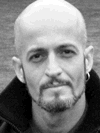Lectures + Discussion, HAU 3: April 14th, 6 pm
Gender and Physicality – An Ambivalent Discussion
A Discussion on Sexuality and Gender and How These Aspects are Artistically Presented and Represented.
Moderated by: Susanne Foellmer
Neither ‘He’ nor ‘She’: Just Teens
 Ana Cristina de Rezende Chiara (Ana Chiara). PhD in literature from PUC-RJ. Since 1995 Professor of Brazilian literature at UERJ. Her studies concentrate on the body, sexuality and memory. She is presently interested in graphic images and words, which showcase the necessity of the ephemerality of forms, or physical forms that have never existed before. Above all, her interests lie in the possibilities that these artificial languages proclaim in the context of contemporary cultural transformations: “fields, in which new sensitivity creates itself” (Raul Antelo). She is the author of the following books: Pedro Nava: um homem no limiar (EDUERJ, 2001), Ensaios de Possessão (Irrespiráveis) (Caetés, 2006) and the unpublished Teoria em Transe. She is a participant of GT ANPOLL de Literatura Comparada and coordinates the GPESq Corpo & Experiência. (http://gpcorpoexperiencia.blogspot.com/).
Ana Cristina de Rezende Chiara (Ana Chiara). PhD in literature from PUC-RJ. Since 1995 Professor of Brazilian literature at UERJ. Her studies concentrate on the body, sexuality and memory. She is presently interested in graphic images and words, which showcase the necessity of the ephemerality of forms, or physical forms that have never existed before. Above all, her interests lie in the possibilities that these artificial languages proclaim in the context of contemporary cultural transformations: “fields, in which new sensitivity creates itself” (Raul Antelo). She is the author of the following books: Pedro Nava: um homem no limiar (EDUERJ, 2001), Ensaios de Possessão (Irrespiráveis) (Caetés, 2006) and the unpublished Teoria em Transe. She is a participant of GT ANPOLL de Literatura Comparada and coordinates the GPESq Corpo & Experiência. (http://gpcorpoexperiencia.blogspot.com/).
In his famous text “Aul”, Roland Barthes points out the existence of a certain fascism in language that “forces us to speak”. On the level of morphology in Portuguese, there is no possibility to use a neutral form. We either say “he” or “she”. The rock artist Patti Smith writes about her friendship with Robert Mapplethorpe in the book “Só Garotos” (Just Boys). In english the books title is “Just Kids”, referencing their respective ages, but isn’t ambiguous with regard to their gender, as is the case in English. In the Portuguese translation, this raises numerous questions about the 1970’s, as well as questions about changing behavioral patterns, unidentifiable sexual identities (he or she?, unisex fashion), body cult images or neglect of the body, as well as about the deconstruction of the body in photos by artist Mapplethorpe – also used by André Masseno in “Outdoor Corpo Machine”.
The Performances of the Dangerous and Brazilian Contemporary Dance – A Quick Summary
 André Masseno –performer and choreographer. Studied and specialized in Brazilian literature at the UERJ and has a degree in performing arts from the UNIRIO.
André Masseno –performer and choreographer. Studied and specialized in Brazilian literature at the UERJ and has a degree in performing arts from the UNIRIO.
Based on a statement by visual artist José Leonilson – “I have something in me that makes me dangerous” – this lecture takes a closer look at the appreciation of the dangerous in artistic strategies, which communicate with and destroy social reproductions of gender and sexuality. It does this by radically presenting the “other” directly in front of the eyes and expectations of the audience. The performance of the dangerous becomes intelligent and flexible via the staging of a physical pose, which lies between confrontation and solution. This contrasts with the wish for a social sphere of norms and a categorization of the body and behavior that are seen as deviant. Thus I ask: which bodies in Brazilian contemporary dance pose as “the dangerous” ones, i.e., as this “other” with violent presence that prompts us to reconsider?

